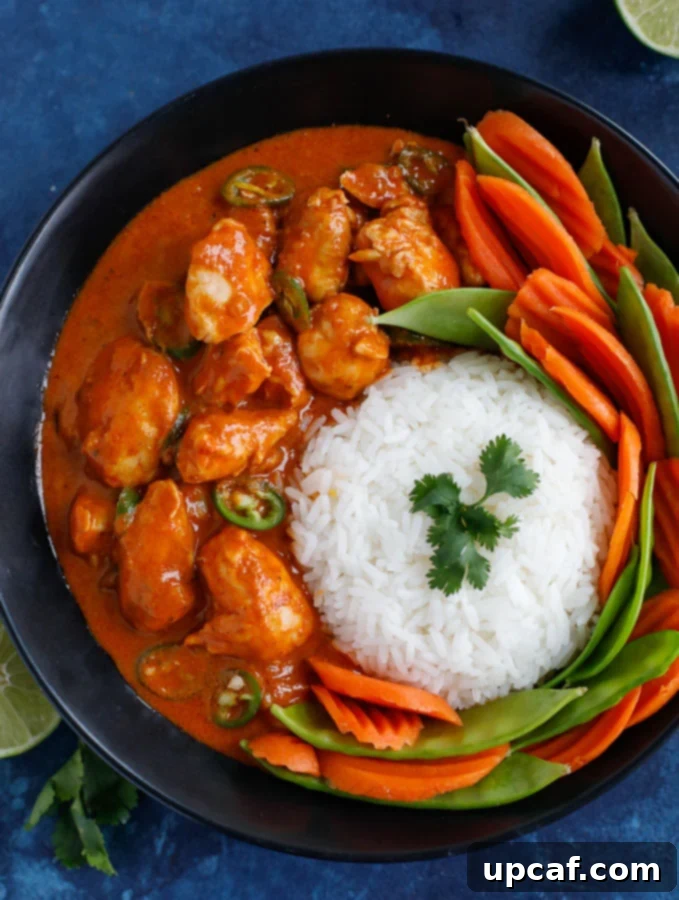Craving an authentic, incredibly flavorful, and deceptively easy Thai dish? Look no further than this fantastic Thai Red Curry Chicken recipe! It’s a harmonious blend of creamy coconut milk, vibrant red curry paste, succulent chicken, and aromatic spices that will transport your taste buds straight to Thailand. This beloved dish is a global favorite for good reason: it’s intensely fragrant, rich in flavor, and surprisingly simple to whip up right in your own kitchen.
Forget the takeout menu this weekend! This homemade Thai Red Curry Chicken offers a healthier, fresher, and just as delicious alternative for your family meal. It’s the perfect way to bring exotic flavors to your dining table without spending hours in the kitchen, proving that gourmet-quality meals can be both quick and accessible.
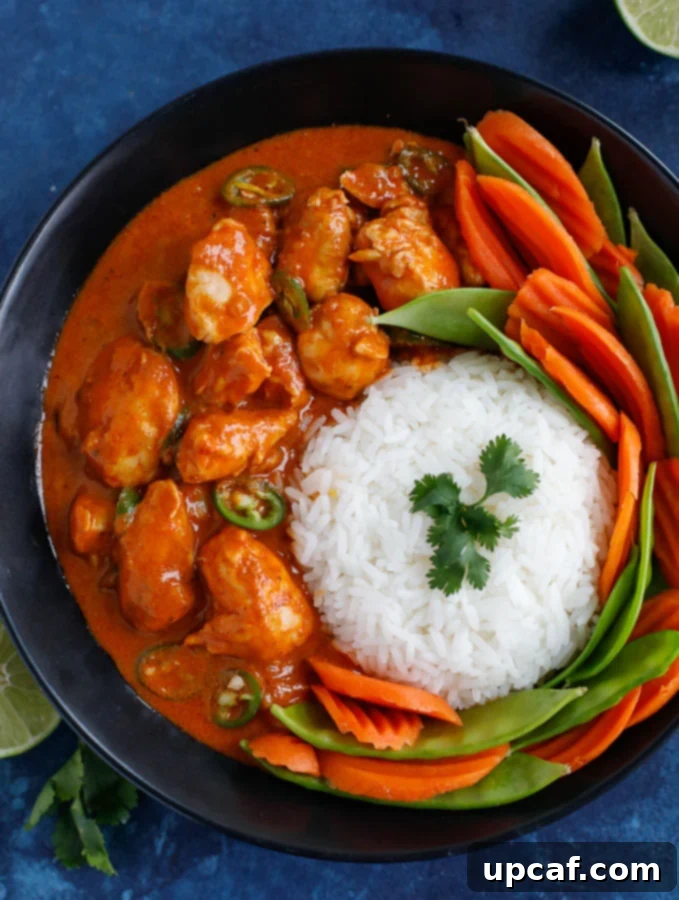
How to Master Thai Red Curry Chicken at Home
While often compared to Indian curries, Thai Red Curry boasts its own distinctive flavor profile, leaning into bright, aromatic, and often spicier notes with a creamy coconut base. This recipe is designed for simplicity without compromising on taste. You’ll be amazed at how quickly tender chicken pieces transform into a fragrant, spicy, and utterly satisfying meal, all prepared in a single pot in just about 30 minutes.
This dish is an ideal choice for both seasoned cooks and those new to Thai cuisine. Its straightforward steps and reliance on readily available ingredients make it a stress-free option for busy weeknights or a relaxed weekend dinner. If you enjoy flavorful chicken dishes, you might also love exploring other recipes like our Chicken Fajita Bake, the indulgent Fajita Chicken Mac N Cheese, or our crispy Air Fryer Chicken Wing Recipe!
Why You’ll Fall in Love with This Thai Red Curry Chicken
There are countless reasons why this Thai Red Curry Chicken will become a staple in your recipe rotation. Here are just a few:
- A Rich and Aromatic Red Curry Sauce: The heart of this dish is its incredible sauce. Creamy, deeply aromatic, and perfectly balanced with a delightful kick of spice, it’s a symphony of flavors that beautifully complements every piece of succulent chicken. Made with full-fat coconut milk and authentic red curry paste, it achieves that signature velvety texture and complex taste that defines great Thai cuisine.
- A Healthier & Fresher Takeout Alternative: Why order in when you can create a superior, healthier version at home? By preparing your own Thai Red Curry, you control the quality of ingredients, reduce sodium and unhealthy fats, and ensure every bite is packed with fresh, wholesome goodness. It’s a guilt-free pleasure that tastes even better than your favorite restaurant dish.
- Effortless One-Pot Cooking: Simplicity is key! This recipe champions the “one-pot meal” philosophy, minimizing cleanup while maximizing flavor. Using common kitchen staples, you can go from pantry to plate in a mere 30 minutes, making it perfect for busy evenings when you need a quick yet impressive meal. It’s an easy-to-follow recipe that yields exceptional results every time.
- Versatility for Every Palate: Whether you prefer a milder curry or crave an extra fiery kick, this recipe is incredibly adaptable. You can easily adjust the spice level to your liking, making it suitable for everyone at the table. It also welcomes a variety of vegetables and protein substitutes, allowing you to customize it based on what you have on hand or what dietary preferences you need to accommodate.
- Impressive Yet Simple: This dish has a sophisticated flavor profile that tastes like it took hours to prepare, yet it’s incredibly simple to execute. It’s an ideal recipe for entertaining guests, as it allows you to spend more time with them and less time fussing in the kitchen. Your friends and family will be impressed by your culinary skills, and you’ll secretly know how easy it was!
The Essence of Thai Red Curry: A Culinary Journey
To truly appreciate this dish, it helps to understand what makes Thai Red Curry so special. Originating from Central Thailand, red curry (Gaeng Phet) is characterized by its vibrant reddish hue, which comes from the red chilies used in its paste. Unlike its green counterpart, red curry tends to be less spicy but equally aromatic and rich. The paste is traditionally made with dried red chilies, galangal, lemongrass, kaffir lime peel, coriander root, coriander seeds, cumin, garlic, shallots, and shrimp paste (for authentic flavor, though vegetarian versions omit this).
When combined with creamy coconut milk, the paste creates a foundation that is both robust and velvety, balancing spicy, sweet, savory, and tangy notes. It’s a complex flavor profile achieved through simple steps, making it a cornerstone of Thai culinary tradition and a dish that truly stands out globally. Understanding these core components enhances the cooking and eating experience.
Essential Ingredients for Your Thai Red Curry Chicken
Gathering quality ingredients is the first step to a magnificent Thai Red Curry. Here’s what you’ll need and why each component is crucial:
- Chicken Tenderloins or Breast: Cut into 1-inch cubes for quick and even cooking. While tenderloins are naturally tender, chicken breast works equally well, offering a lean protein base for your curry. Thighs can also be used for a richer flavor and even more tender texture.
- Large Onion: Petite diced and split, onions provide a foundational sweetness and depth when caramelized, building the first layer of flavor for your sauce.
- Vegetable Oil: For sautéing and caramelizing, ensuring the ingredients cook evenly and release their full aromas.
- Thai Red Curry Paste: This is the soul of your curry. Invest in a good quality paste. Different brands offer varying spice levels and flavor complexities, so experiment to find your favorite. This paste is what gives the curry its characteristic color and fiery, aromatic depth.
- Coconut Milk: Full-fat coconut milk is highly recommended for its richness and creamy texture, which is crucial for a luxurious curry sauce. It balances the spice and forms the smooth base.
- Water: Used to thin the sauce slightly and ensure all flavors meld together perfectly during simmering.
- Black Pepper & Salt: Essential seasonings to enhance the overall taste and bring out the natural flavors of the other ingredients. Adjust to your preference.
- Grated Ginger & Minced Garlic: These aromatic powerhouses are fundamental to many Asian dishes, providing a pungent, warm base that elevates the curry’s fragrance.
- Sliced Shallots: Offering a milder, sweeter, and more delicate flavor than onions, shallots add another layer of aromatic complexity.
- Fresh Cilantro: Chopped cilantro is used both in the curry for freshness and as a garnish, providing a bright, herbaceous finish that perfectly complements the rich sauce.
- Fresh Lime Juice: A squeeze of fresh lime juice at the end is non-negotiable! It brightens the entire dish, cutting through the richness and adding a crucial tangy note that balances the flavors.

Step-by-Step Preparation for Thai Red Curry Chicken
Follow these detailed instructions to create your exquisite Thai Red Curry Chicken:
- Prepare Your Ingredients: Begin by cutting the chicken (tenderloins or breast) into uniform 1-inch cubes. Dice the large onion, slice the shallots, grate the fresh ginger, chop the cilantro, and mince the garlic. Having all your ingredients prepped and ready makes the cooking process smooth and enjoyable.
- Cook the Chicken: In a large pan or Dutch oven, heat 2 tablespoons of vegetable oil over medium-high heat. Add half of the diced onion and sauté until lightly caramelized and fragrant, about 2-3 minutes. Then, add the cubed chicken to the pan. Cook the chicken, stirring occasionally, until it is about three-quarters cooked through and lightly browned on all sides. This searing locks in flavor. Once cooked, remove the chicken from the pan and set it aside in a bowl.
- Build the Aromatic Curry Base: Add the remaining 1 tablespoon of vegetable oil to the same pan. If needed, deglaze the pan with a splash of water to loosen any browned bits, which are packed with flavor. Add the remaining diced onions and sauté until softened and translucent, about 2 minutes. Stir in the minced garlic and sauté for another 30 seconds until fragrant, being careful not to burn it.
- Bloom the Spices and Curry Paste: Add the grated ginger, fresh lime juice, sliced shallots, black pepper, salt, and the star of the show – the Thai red curry paste – to the pan. Mix everything thoroughly, stirring constantly for about 30-60 seconds. This “blooming” process toasts the spices and curry paste, intensifying their flavors and aromas before adding the liquid.
- Create the Creamy Sauce: Pour in the coconut milk and water. Stir everything well until the curry paste is fully dissolved and the sauce is smooth. Bring the mixture to a gentle simmer over low heat. Let it simmer for 2-3 minutes, allowing the flavors to meld beautifully and the sauce to thicken slightly.
- Combine & Finish: Return the partially cooked chicken cubes to the pan, along with the freshly chopped cilantro. Stir to coat the chicken evenly with the rich curry sauce. Continue to cook on low heat for another 3-4 minutes, or until the chicken is fully cooked through and tender, and the sauce has reached your desired consistency.
- Serve and Garnish: Remove the pan from the stove. Garnish your exquisite Thai Red Curry Chicken with a sprinkle of fresh cilantro and some thinly sliced serrano peppers for an extra pop of color and freshness. Serve immediately with a side of fluffy white rice and your choice of steamed or sautéed vegetables. Enjoy the vibrant flavors!

Essential Tips for the Perfect Thai Red Curry Chicken
Elevate your Thai Red Curry Chicken with these expert tips and tricks:
- Always Opt for Full-Fat Coconut Milk: For that truly authentic, rich, and velvety sauce consistency, full-fat coconut milk is non-negotiable. Reduced-fat versions will yield a thinner, less luxurious sauce that won’t have the same depth of flavor or mouthfeel. Shake the can well before opening to ensure the cream and liquid are combined.
- Coconut Milk Alternative: If coconut milk isn’t available or preferred, you can substitute it with ½ cup of heavy cream. Be aware that this will alter the flavor profile slightly, giving it a more European-style creaminess rather than the distinct Thai coconut flavor.
- Adjusting the Spice Level: To increase the heat, add some diced or thinly sliced serrano peppers to the pan at the same time you reintroduce the chicken and cilantro. For a milder heat from peppers like jalapeños, make sure to remove their seeds and internal ribs before dicing, as these contain most of the capsaicin. A pinch of red chili flakes can also be stirred in for an adjustable spice boost.
- The Magic of Kaffir Lime Leaves: For an authentic, earthy citrus aroma that truly enhances Thai cuisine, add 2-3 kaffir lime leaves to the simmering sauce. Bruise them slightly to release their essential oils. Remember to remove them before serving, as they are not meant to be eaten. You can usually find fresh or frozen kaffir lime leaves in Asian grocery stores.
- Garnish for Freshness and Appeal: A vibrant garnish not only adds visual appeal but also a burst of fresh flavor. Finish your dish with extra chopped cilantro, a few thinly sliced serrano peppers, or a scattering of toasted peanuts for added texture and richness.
- Serving Suggestions: The classic accompaniment is fluffy white jasmine rice, which perfectly absorbs the delicious curry sauce. For a low-carb alternative, consider cilantro cauliflower rice. You can also serve it with a side of steamed or stir-fried vegetables of your choice, such as broccoli, bell peppers, or snap peas.
- Adding Vegetables to the Curry: For a more substantial meal, pre-cook your desired vegetables (like bell peppers, broccoli florets, or zucchini slices) until they are tender-crisp. Add them to the curry during the last few minutes of cooking with the chicken, allowing them to warm through and soak up the flavorful sauce without becoming overcooked.
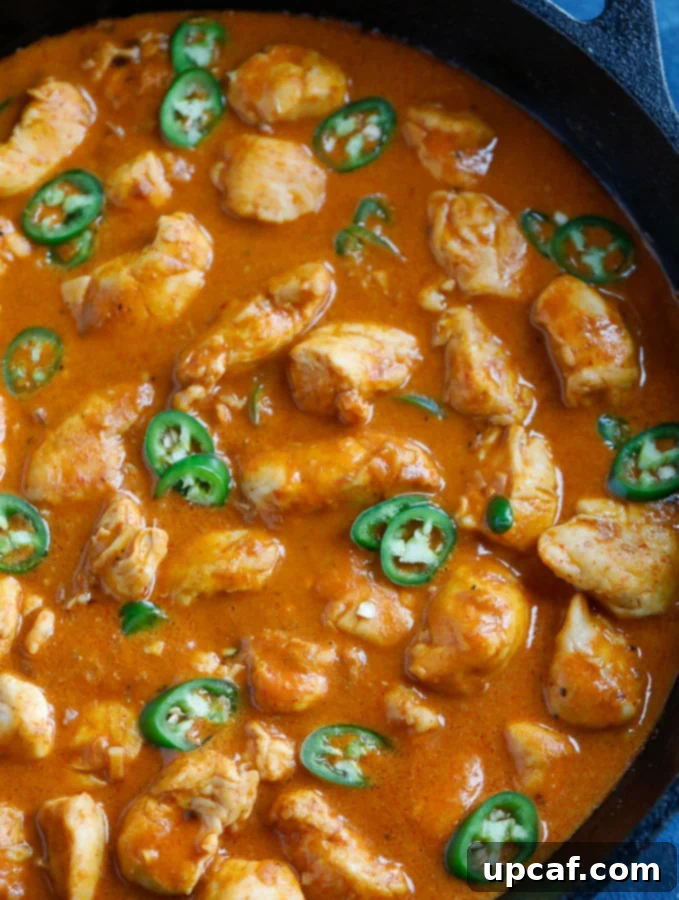
Frequently Asked Questions (FAQs) About Thai Red Curry Chicken
What other vegetables can I add to this curry?
There are no strict rules when it comes to adding vegetables to your Thai Red Curry – feel free to get creative! The key is to slice them into roughly similar, small sizes for even cooking. Excellent additions include cauliflower florets, broccoli florets, sliced mushrooms, diced butternut squash, zucchini, and yellow squash. Some people also enjoy sautéing red bell peppers or bamboo shoots and adding them towards the end. If you’re a fan of peanuts, toss in some toasted peanuts as a garnish when serving for extra crunch and flavor.
Can I use other protein sources?
Absolutely! While this recipe features chicken tenderloins, it’s incredibly versatile. This curry works wonderfully with a variety of proteins. Consider using firm tofu (pressed and lightly fried for best texture), thinly sliced beef, flaky salmon fillets, or quick-cooking shrimp. For a plant-based option, you can easily substitute the chicken with a generous amount of mixed vegetables and chickpeas or lentils, making it a hearty vegetarian or vegan meal.
What to serve with this Thai Red Curry Chicken?
The classic accompaniment is steamed white jasmine rice, which is perfect for soaking up every drop of that delicious sauce. For a lighter, low-carb alternative, consider serving it with cilantro cauliflower rice. Beyond rice, warm naan bread or soft pita slices are fantastic for scooping up the creamy curry. You can also pair it with a simple side salad or stir-fried greens to complete your meal.
Can I make Thai Red Curry Chicken ahead of time or meal prep it?
Yes, this Thai Red Curry Chicken is an excellent candidate for meal prepping! The flavors often deepen and meld even better after a day or two in the refrigerator. Prepare the full recipe, then portion it into airtight containers. It will keep well in the refrigerator for up to 3-4 days. For longer storage, freeze it in individual portions for up to 2-3 months. Thaw overnight in the refrigerator and reheat gently on the stovetop or in the microwave.
What’s the difference between red, green, and yellow Thai curries?
Thai curries are primarily distinguished by their curry paste, which dictates their color, spice level, and core aromatics.
- Red Curry (Gaeng Phet): Known for its vibrant red color from dried red chilies. It’s typically medium spicy and very aromatic, balancing savory, sweet, and slightly spicy notes with a rich coconut base.
- Green Curry (Gaeng Keow Wan): Often considered the spiciest and most herbaceous, it gets its green color from fresh green chilies and fresh herbs like basil and kaffir lime leaves. It’s sweeter and more pungent than red curry.
- Yellow Curry (Gaeng Garee): The mildest of the three, it gets its yellow hue from turmeric and often includes Indian-inspired spices like curry powder. It’s usually richer, sweeter, and less spicy, often paired with potatoes.
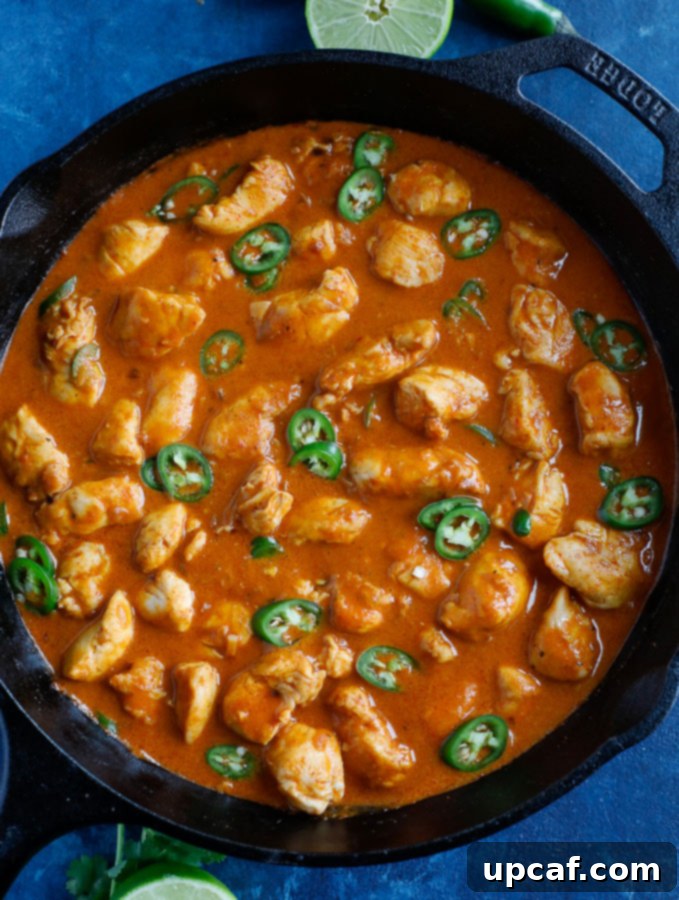
Other Delightful Asian-Inspired Recipes to Explore
- Easy Orange Chicken Recipe
- Spicy Sriracha Chicken
- Lemon Garlic Butter Scallops
- Spicy Cashew Chicken
- Paneer Pasanda
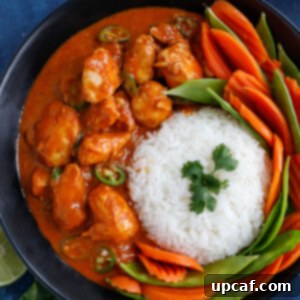
Thai Red Curry Chicken Recipe
This Thai Red Curry Chicken recipe is a super easy, flavorful Thai recipe you can enjoy at home and can be ready in as little as 30 minutes.
Ingredients
- 2 lbs. Chicken tenders or breast, cut into 1 inch cubes
- 1 large onion, petite diced and split into two
- 3 tbsps. vegetable oil
- 1/4 cup Thai red curry paste
- 3/4 cup coconut milk (full-fat recommended)
- 1/2 cup water
- 1 Tbsp. black pepper
- 1 Tbsp. grated ginger
- 1/4 cup shallots, sliced
- 2 Tbps. fresh cilantro, chopped
- 2 cloves garlic, minced
- 2 tbsps. fresh lime juice
- 1 tsp. salt
Instructions
- Cut the chicken into 1-inch cubes. Dice the onions, slice shallots, grate the ginger, chop the cilantro, and mince the garlic.
- In a large pan or Dutch oven, heat 2 tablespoons of vegetable oil. Caramelize half the onion until fragrant, then add in the chicken. Cook the chicken until it is about three-quarters cooked through. Set the chicken aside in a bowl.
- Add the remaining 1 tablespoon of oil into the pan. Sauté the remainder of the onions until softened. Add in the minced garlic and sauté for another 30 seconds.
- Stir in the grated ginger, lime juice, sliced shallots, black pepper, salt, and Thai red curry paste. Mix well and cook for another 30-60 seconds to bloom the spices.
- Add in the coconut milk and water. Stir well to combine all ingredients, then let the sauce simmer gently for 2-3 minutes on low heat.
- Return the chicken cubes and chopped cilantro to the pan. Cook together with the sauce for another 3-4 minutes on low, or until the chicken is fully cooked and tender.
- Remove the dish from the stove. Garnish with some fresh cilantro and thinly sliced serrano peppers (optional). Serve immediately with cooked rice and your choice of vegetables.
Notes
- Ideally, use full-fat coconut milk for a smooth, thick, and rich sauce consistency. Reduced-fat versions will not yield the same creamy result.
- If coconut milk is unavailable, you can use 1/2 cup of heavy cream, but note that the flavor will differ slightly from a traditional Thai curry.
- To increase the spiciness, add some diced or sliced serrano peppers when you add the chicken and cilantro back to the sauce.
- If you’re using jalapeños and prefer a milder heat, remove the seeds and white ribs before dicing them.
- For an authentic earthy citrus flavor, add a couple of kaffir lime leaves to the simmering sauce. Remember to remove them before serving.
- Garnish the finished dish with extra sliced serrano peppers and fresh cilantro. It pairs wonderfully with a side of white rice and your favorite steamed or stir-fried vegetables.
- You can cook vegetables ahead of time and stir them into the dish towards the end, allowing them to heat through with the chicken for a few minutes.
Nutrition
Carbohydrates: 7g |
Protein: 34g |
Fat: 18g |
Saturated Fat: 13g |
Cholesterol: 97mg |
Sodium: 503mg |
Potassium: 716mg |
Fiber: 2g |
Sugar: 2g |
Vitamin A: 1944 IU |
Vitamin C: 8mg |
Calcium: 48mg |
Iron: 2mg
I genuinely hope you enjoy exploring all the delicious recipes I share with you, and this Thai Red Curry Chicken recipe is no exception. Give it a try, savor its incredible flavors, and don’t forget to rate it and share your culinary adventure with your friends and family!
